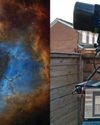
If you keep travelling in an imaginary faster-than-light spaceship, would you ever arrive at some boundary, unable to go any further? And if so, what lies beyond? It's all very hard to imagine. Then again, an infinite Universe is just as difficult to wrap your head around. After all, there must be something that space is expanding into, right?
Let's start with a related but easier-to-grasp concept: our Universe has an apparent edge, called the cosmological horizon. The light emitted right after the Big Bang has been travelling for 13.8 billion years through space. This means we can only see the Universe up to a current distance corresponding to a light-travel time of 13.8 billion years. Thanks to the expansion of space, this so-called co-moving distance is approximately 45 billion lightyears, and anything beyond this limit is unobservable to us because not enough time has elapsed since the birth of the Universe for light from these remote regions to reach our telescopes.
But, just like the familiar horizon seen by sailors on the ocean, this cosmological horizon is not some real, physical boundary. And as the ocean stretches beyond the sailor's horizon, so too does space stretch beyond our observable Universe. There's no reason why there can't be galaxies at these extremely large distances; they're just invisible to us, no matter how powerful our telescopes are.
هذه القصة مأخوذة من طبعة April 2023 من BBC Sky at Night Magazine.
ابدأ النسخة التجريبية المجانية من Magzter GOLD لمدة 7 أيام للوصول إلى آلاف القصص المتميزة المنسقة وأكثر من 9,000 مجلة وصحيفة.
بالفعل مشترك ? تسجيل الدخول
هذه القصة مأخوذة من طبعة April 2023 من BBC Sky at Night Magazine.
ابدأ النسخة التجريبية المجانية من Magzter GOLD لمدة 7 أيام للوصول إلى آلاف القصص المتميزة المنسقة وأكثر من 9,000 مجلة وصحيفة.
بالفعل مشترك? تسجيل الدخول

Putting cosmic rays to work
These penetrating interstellar particles have applications from astronomy to archaeology

Set up your first imaging sequence
How to automate and coordinate your gear over multiple nights of imaging

The Universe without gravity
Life with no gravity might sound a fun idea, but as Govert Schilling explains, shutting off this pivotalforce would spell disaster for Earth and beyond

How to blend images taken with different camera setups
Combine data captured at varied focal lengths to create rich, deep images

INSIDE THE SKY AT NIGHT
Back in September 2021, The Sky at Night show spoke to Carly Howett about NASA's then upcoming Lucy mission. As the spacecraft now approaches its main targets - the Trojan asteroids - we check in with her to see how the mission is going

The science of SCI-FI
We love a good sci-fi film, but do they get the science right? Amy Arthur picks six of the big mistakes made in space films

Seeing in a new light
It's National Astronomy Week this month, so take a tip from Mark Westmoquette and let mindful stargazing change your perspective on your life and problems

What to do if you find a meteorite
Ever come across an unusual rock and wondered if it's a meteorite? Mark McIntyre explains how to tell if that stone really is a fragment from outer space

GEAR
Charlotte Daniels rounds up the latest astronomical accessories

Q&A WITH A STELLAR ECLIPSE SPECIALIST
Many stars are gravitationally locked inside multi-star systems, but a rare new triple-star system has set a new record for how cosy these clusters can get